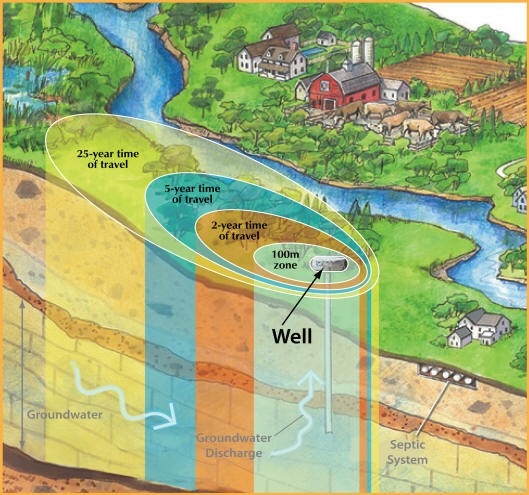Figure: Wellhead Protection Areas and Intake Protection Zones The amount of land involved in a wellhead protection area is determined by a variety of factors such as the way the land rises or falls, the amount of water being pumped, the type of aquifer, the type of soil surrounding the well, and the direction and speed that groundwater travels. 100-metre area: The area where the risk to the well is highest and the greatest care should be taken in handling any potential contaminant. 2-year time of travel: In the second ring, bacteria and viruses from human and animal waste are a concern, as are hazardous chemicals. 5-year time of travel: Biological contaminants are less of a concern in the third ring but chemical pollutants remain a concern. 25-year time of travel: The most persistent and hazardous pollutants remain a concern. |
Nitrate: The Vulnerability
Single family households that ingest nitrate at a concentration above 10 mg/L are considered to be at risk by the EPA. Excessive levels of nitrate in single well household delivery systems has toxic effects in pregnant women, infants, and the elderly. The serious illness, methemoglobinemia, is due to the conversion of nitrate to nitrite by the body, which can interfere with the oxygen-carrying capacity of the blood.
Undetectable to our senses, nitrate has no color, taste or smell at concentrations observed in drinking water supplies. Nitrate does not cause discoloration of plumbing fixtures and does not affect laundering or other non-potable domestic water uses. Nitrates present in a water supply can be indication of other contaminants in that source of water. Levels of nitrate above background concentrations from the following sources may indicate the presence of other contaminants in well water: 1
- Faulty septic tank or nearby animal feedlot: Nitrate contamination in well water from human or animal waste may mean that microbial contaminants are also present.
- Agricultural or residential fertilizer use. Wells with nitrate contamination from fertilizers may also contain pesticides.
1 DeSilva, Francis J. "Nitrate Removal by Ion Exchange." Water & Wastes Digest. (2003): 9-11.30. Print.
